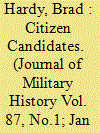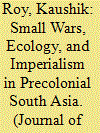|
|
|
Sort Order |
|
|
|
Items / Page
|
|
|
|
|
|
|
| Srl | Item |
| 1 |
ID:
188986


|
|
|
|
|
| Summary/Abstract |
The passage of the Lodge Act in 1950 enabled the United States to offer citizenship to foreign nationals in exchange for service in the U.S. Army. A chief objective was to further Cold War goals by enlisting Eastern European candidates to serve as special forces troops, linguists, cultural experts, and skilled technicians. The legislation sought to spread American values abroad and unify support at home. Its chief legacy, however, was to serve as a template for naturalizing those who served in the decades that followed. “Citizen Candidates” won first place in the 2021 VMI Adams Center Cold War Military history essay contest.
|
|
|
|
|
|
|
|
|
|
|
|
|
|
|
|
| 2 |
ID:
188983


|
|
|
|
|
| Summary/Abstract |
In 1914, the British Army was organized and trained in compliance with Field Service Regulations (FSR). Douglas Haig stated that “a steady adherence” to their “principles,” had enabled success on the Western Front. Despite its impact on the British Army from 1902, however, FSR has been widely disregarded or misrepresented, partly due to a misconceived belief that Haig embodied these principles. Haig played no part in establishing FSR and did not, from 1909, reform his command and tactical principles in line with it. If Haig had adhered to the principles he extolled in 1918, the British Army of 1916 would have been in better shape.
|
|
|
|
|
|
|
|
|
|
|
|
|
|
|
|
| 3 |
ID:
188985


|
|
|
|
|
| Summary/Abstract |
Following World War II, General Heinz Guderian claimed authorship of the development of Germany’s Panzer arm, which he had led to successes at the war’s start. In fact, Guderian had little influence on the foundation of the Reichswehr’s mechanized forces. He had built on the work of Germany’s first armored warfare theorist: Ernst Volckheim. One of few German officers to command a tank in World War I, Volckheim was Germany’s leading theorist of tank warfare in the 1920s. His work would reshape decisions crucial to Germany’s development of armored forces in World War II. This article reassesses Volckheim’s influence on German training, doctrine, and tank design.
|
|
|
|
|
|
|
|
|
|
|
|
|
|
|
|
| 4 |
ID:
188982


|
|
|
|
|
| Summary/Abstract |
The eight senior military colleges—the U.S. Military Academy, U.S. Naval Academy, Norwich University, Virginia Military Institute, Citadel, Virginia Tech, University of North Georgia, and Texas A&M–maintain honor codes often seen as having originated in the nineteenth century. In fact, none had written honor codes until the twentieth century. What did develop in the nineteenth century was the concept of honor, with striking similarities among the colleges. Their emphasis on strict discipline, rigorous academics, and Christian ideals, drawn from the military service and regional cultures, were the foundation for such honor concepts as restrained manhood, gentlemanly behavior, and self-discipline—and ultimately, of the individual honor codes.
|
|
|
|
|
|
|
|
|
|
|
|
|
|
|
|
| 5 |
ID:
188984


|
|
|
|
|
| Summary/Abstract |
The accusation frequently levelled at official history is that it is beholden to government and this relationship limits its honesty and impartiality. One example of this is the depiction of the introduction of the convoy system in the official British history of the First World War. According to one popular narrative, this came about only because determined, far-seeing politicians overrode reactionary senior admirals. The official history offered an account more favorable to the navy and, therefore, it has been characterized as a whitewash. This article shows that while individual naval officers and the Admiralty had a voice in the production of the text, their input led to a better, more balanced product, with fewer errors and a greater sense of the complexity of the issues. This furthers the argument that official history that incorporates such voices is generally better for it.
|
|
|
|
|
|
|
|
|
|
|
|
|
|
|
|
| 6 |
ID:
188980


|
|
|
|
|
| Summary/Abstract |
This article uses the concept of “small war” to analyze military confrontations between the Mughal Empire and the Ahom Kingdom of Assam during the seventeenth century. The Mughals launched a series of conventional campaigns on the land and along the rivers. The Ahoms responded with both conventional and guerrilla attacks. For the Mughals, military operations in Assam were limited wars; the Ahom monarchy was a nuisance. However, the Mughal Empire posed an existential threat to the Ahom Kingdom, and the Ahoms fought for their survival. In the Mughal-Ahom confrontations, geography and managerial factors functioned as crucial drivers. Despite technical and firepower superiority, the Mughals were defeated.
|
|
|
|
|
|
|
|
|
|
|
|
|
|
|
|
| 7 |
ID:
188981


|
|
|
|
|
| Summary/Abstract |
The French Revolution’s first three years were marked by fighting between different armed groups in a fluid field of violence among armed state, nonstate, and quasi-state actors. The forces of order were less organized than their titles would indicate, while opposition forces were better organized and trained than they portrayed themselves to be. Paris was a military theatre where victory was determined by the opposition’s ability to attract both armed fighters and widespread popular support, though a government that was unpopular with the population of Paris but that had the support of the city’s military could continue to rule. Governments fell when they lost control of military forces.
|
|
|
|
|
|
|
|
|
|
|
|
|
|
|
|
|
|
|
|
|